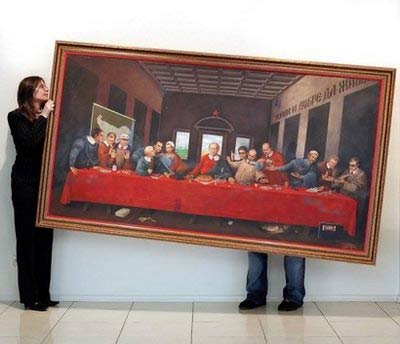A pair of US academics have analysed 52 of the most famous paintings of the Last Supper painted between 1000 and 2000 -- and discovered that, over that period, the portions of food placed before Jesus and his disciples grew astonishingly.
近日,美国两位学者对1000年至2000年间绘制的52幅以“最后的晚餐”为主题的著名画作进行分析比较后发现,在这一时期内,画中摆放在耶稣和他的信徒面前的食物份量不断增加。
Using computer-aided design technology, they scanned the main dish, bread and plates and calculated the size of portion relative to the size of the average head in the painting.
研究人员采用电脑设计技术对画中的主菜、面包和餐盘进行了扫描,并计算出食物的尺寸与画中人物头的尺寸之间的比例。
Over a thousand years, the size of the main dish progressively grew by 69.2 per cent, plate size by 65.6 percent and bread size by 23.1 percent, they found.
研究人员发现,在这一千多年间,画中的主菜、餐盘和面包的尺寸分别增加了69.2%、65.6% 和23.1%。

The growing size reflects the success of agriculture over the ages, the researchers said.
研究人员称,食物和餐盘尺寸的增长反映出这么多年来农业产量的增加。
"The last thousand years have witnessed dramatic increases in the production, availability, safety, abundance and affordability of food," said Brian Wansink, a professor of marketing and applied economics at Cornell University.
康奈尔大学营销和应用经济学教授布赖恩·万辛克说:“在过去一千年间,食物的生产、可用性、安全性、 丰富程度以及可购性都大幅提高。”
"We think that as art imitates life, these changes have been reflected in paintings of history's most famous dinner."
“我们认为,由于艺术描绘的是现实生活,所以这些变化也反映在这一史上最著名的晚餐的画作之中。”
The study, published in Britain's International Journal of Obesity, is co-authored by Wansink's brother, Craig, a Presbyterian minister and professor of religious studies at Virginia Wesleyan College.
该研究报告在英国《国际肥胖杂志》上发表,由万辛克和他的兄弟、弗吉尼亚卫斯理公会学院宗教学教授、长老会牧师克雷格共同撰写。
The Bible makes no mention of what was eaten at the Last Supper. But the main dishes depicted in the paintings contained fish or eel (18 percent), lamb (14 percent) and pork (seven percent).
《圣经》中并未提及《最后的晚餐》中有哪些食物,但画作中出现的主菜包括鱼肉或鳗鱼(18%)、羊肉(14%)以及猪肉(7%)等。












